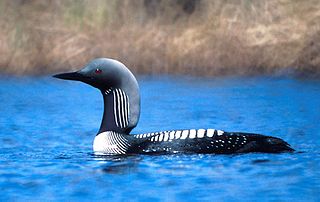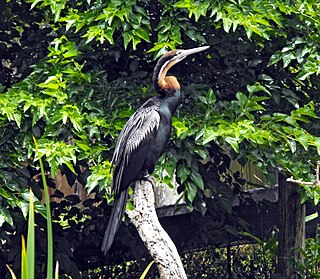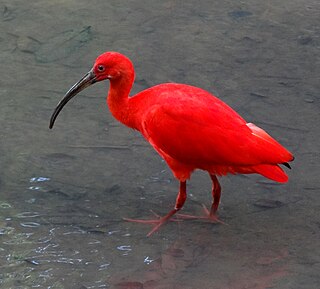
Loons or divers are a group of aquatic birds found in much of North America and northern Eurasia. All living species of loons are members of the genus Gavia, family Gaviidae and order Gaviiformes.

Grebes are aquatic diving birds in the order Podicipediformes. Grebes are widely distributed freshwater birds, with some species also found in marine habitats during migration and winter. Some flightless species exist as well, most notably in stable lakes. The order contains a single family, the Podicipedidae, which includes 22 species in six extant genera. Although, superficially, they resemble other diving birds such as loons and coots, they are most closely related to flamingos, as supported by morphological, molecular and paleontological data. Many species are monogamous and are known for their courtship displays, with the pair performing synchronized dances across the water's surface. The birds build floating vegetative nests where they lay several eggs. About a third of the world's grebes are listed at various levels of conservation concerns—the biggest threats including habitat loss, the introduction of invasive predatory fish and human poaching. As such, three species have gone extinct.

The darters, anhingas, or snakebirds are mainly tropical waterbirds in the family Anhingidae, which contains a single genus, Anhinga. There are four living species, three of which are very common and widespread while the fourth is rarer and classified as near-threatened by the IUCN. The term snakebird is usually used without any additions to signify whichever of the completely allopatric species occurs in any one region. It refers to their long thin neck, which has a snake-like appearance when they swim with their bodies submerged, or when mated pairs twist it during their bonding displays. "Darter" is used with a geographical term when referring to particular species. It alludes to their manner of procuring food, as they impale fishes with their thin, pointed beak. The American darter is more commonly known as the anhinga. It is sometimes called "water turkey" in the southern United States; though the anhinga is quite unrelated to the wild turkey, they are both large, blackish birds with long tails that are sometimes hunted for food.

The horned grebe or Slavonian grebe is a relatively small waterbird in the family Podicipedidae. There are two known subspecies: P. a. auritus, which breeds in the Palearctic, and P. a. cornutus, which breeds in North America. The Eurasian subspecies is distributed over most of northern Europe and the Palearctic, breeding from Greenland to western China. The North American subspecies spans most of Canada and some of the United States. The species got its name from large patches of yellowish feathers located behind the eyes, called "horns", that the birds can raise and lower at will.

The black-necked grebe or eared grebe is a member of the grebe family of water birds. It was described in 1831 by Christian Ludwig Brehm. There are currently three accepted subspecies, including the nominate subspecies. Its breeding plumage features a distinctive ochre-coloured plumage which extends behind its eye and over its ear coverts. The rest of the upper parts, including the head, neck, and breast, are coloured black to blackish brown. The flanks are tawny rufous to maroon-chestnut, and the abdomen is white. When in its non-breeding plumage, this bird has greyish-black upper parts, including the top of the head and a vertical stripe on the back of the neck. The flanks are also greyish-black. The rest of the body is a white or whitish colour. The juvenile has more brown in its darker areas. The subspecies californicus can be distinguished from the nominate by the former's usually longer bill. The other subspecies, P. n. gurneyi, can be differentiated by its greyer head and upper parts and by its smaller size. P. n. gurneyi can also be told apart by its lack of a non-breeding plumage. This species is present in parts of Africa, Eurasia, and the Americas.

Phalacrocoracidae is a family of approximately 40 species of aquatic birds commonly known as cormorants and shags. Several different classifications of the family have been proposed, but in 2021 the IOC adopted a consensus taxonomy of seven genera. The great cormorant and the common shag are the only two species of the family commonly encountered in Britain and Ireland and "cormorant" and "shag" appellations have been later assigned to different species in the family somewhat haphazardly.

The black geese of the genus Branta are waterfowl belonging to the true geese and swans subfamily Anserinae. They occur in the northern coastal regions of the Palearctic and all over North America, migrating to more southernly coasts in winter, and as resident birds in the Hawaiian Islands. Alone in the Southern Hemisphere, a self-sustaining feral population derived from introduced Canada geese is also found in New Zealand.

Hesperornithes is an extinct and highly specialized group of aquatic avialans closely related to the ancestors of modern birds. They inhabited both marine and freshwater habitats in the Northern Hemisphere, and include genera such as Hesperornis, Parahesperornis, Baptornis, Enaliornis, and Potamornis, all strong-swimming, predatory divers. Many of the species most specialized for swimming were completely flightless. The largest known hesperornithean, Canadaga arctica, may have reached a maximum adult length of 2.2 metres (7.2 ft).

Podiceps is a genus of birds in the grebe family. The genus name comes from Latin podicis, "rear-end" and ped, "foot", and is a reference to the placement of a grebe's legs towards the rear of its body.

Eudocimus is a genus of ibises, wading birds of the family Threskiornithidae. They occur in the warmer parts of the New World with representatives from the southern United States south through Central America, the West Indies, and South America.
Megapaloelodus is an extinct genus of stem flamingo of the family Palaelodidae. Megapaloelodus is primarily known from Miocene America, from South Dakota and Oregon in the north to Argentina in the south, but the species Megapaloelodus goliath was found in Europe. Additionally, one unnamed species was discovered in Miocene sediments from Namibia. Due to a lack of skull material, little can be said about the ecology of Megapaloelodus. Species of this genus are typically larger than those of Palaelodus and appear to have inhabited similar brackish lake environments. Additionally, they may have been capable of "locking" their legs in a standing position.
Annakacygna is a genus of flightless marine swan from the Miocene of Japan. Named in 2022, Annakacygna displays a series of unique adaptations setting it apart from any other known swan, including a filter feeding lifestyle, a highly mobile tail and wings that likely formed a cradle for their hatchlings in a fashion similar to modern mute swans. Additionally, it may have used both wings and tail as a form of display. All of these traits combined have led the researchers working on it to dub it "the ultimate bird". Two species are known, A. hajimei, which was approximately the size of a black swan, and A. yoshiiensis which exceeded the mute swan in both size and weight. The describing authors proposed the vernacular name Annaka short-winged swan for the genus.

Thiornis is a fossil genus of Middle Miocene grebe known from a nearly complete specimen from Libros, Spain. Originally classified as a type of moorhen, Thiornis has since been classified as a species of grebe. The overall anatomy of the bird is identical to modern grebes. It contains a single species, T. sociata.
Pliolymbus is a fossil genus of grebe known from the Late Pliocene to Early Pleistocene of United States and Mexico. It is known from a single species, P. baryosteus.
Aechmophorus elasson is an extinct species of grebe recovered from the Piacenzian age of the United States.
Podilymbus majusculus is an extinct species of grebe recovered from the Piacenzian age of the United States.
Podiceps oligoceanus is an extinct species of grebe possibly from the Neogene period which the specimen has been found in the United States.
Podiceps howardae is a possible extinct species of grebe from the United States, possibly a larger and earlier form of the horned grebe.
Podiceps solidus is an extinct small species of Upper Miocene to Lower Pliocene grebe from Western Mongolia.
Podiceps arndti is an extinct species of grebe from the Upper Pliocene of California.










